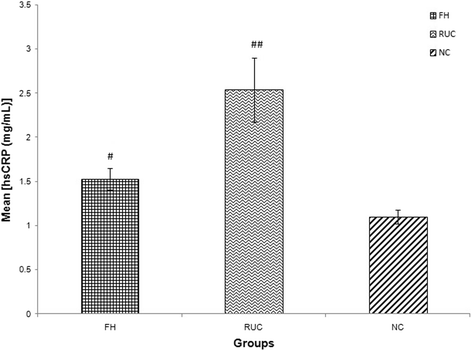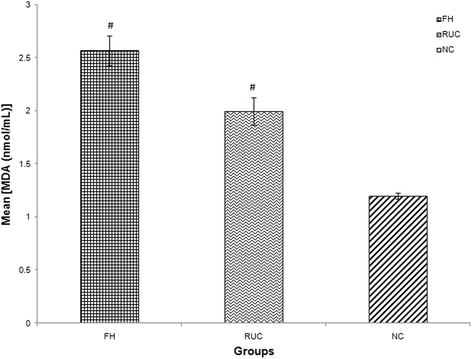Enhanced status of inflammation and endothelial activation in subjects with familial hypercholesterolaemia and their related unaffected family members: a case control study
- PMID: 28438163
- PMCID: PMC5404314
- DOI: 10.1186/s12944-017-0470-1
Enhanced status of inflammation and endothelial activation in subjects with familial hypercholesterolaemia and their related unaffected family members: a case control study
Abstract
Background: Familial hypercholesterolaemia (FH) leads to premature coronary artery diseases (CAD) which pathophysiologically can be measured by inflammation, endothelial activation and oxidative stress status. However, the status of these biomarkers among related unaffected relatives of FH cases and whether FH is an independent predictor of these biomarkers have not been well established. Thus, this study aims to (1) compare the biomarkers of inflammation, endothelial activation and oxidative stress between patients with FH, their related unaffected relatives (RUC) and normolipaemic subjects (NC) (2)determine whether FH is an independent predictor of these biomarkers.
Methods: One hundred thirty-one FH patients, 68 RUC and 214 matched NC were recruited. Fasting lipid profile, biomarkers of inflammation (hsCRP), endothelial activation (sICAM-1 and E-selectin) and oxidative stress [oxidized LDL (oxLDL), malondialdehyde (MDA) and F2-isoprostanes (ISP)] were analyzed and independent predictor was determined using binary logistic regression analysis.
Results: hsCRP was higher in FH and RUC compared to NC (mean ± SD = 1.53 ± 1.24 mg/L and mean ± SD = 2.54 ± 2.30 vs 1.10 ± 0.89 mg/L, p < 0.05). sICAM-1 and E-selectin were higher in FH compared to NC (mean ± SD = 947 ± 742 vs 655 ± 191 ng/mL, p < 0.001 and 175 ± 131 vs 21.6 ± 10.7 ng/mL, p < 0.001 respectively) while sICAM-1 concentration was higher in RUC compared to NC (mean ± SD = 945 ± 379 vs 655 ± 191 ng/mL, p < 0.01). Biomarkers of oxidation (ox-LDL, MDA and ISP) were elevated in FH compared to NC [mean ± SD = (48.2 ± 26.8 vs 27.3 ± 13.2 mU/L, p < 0.001), (2.57 ± 1.3 vs 1.20 ± 0.30 nmol/mL, p < 0.001) and (645 ± 396 vs 398 ± 20.5 pg/L, p < 0.001) respectively], but no significant differences were observed between RUC and NC (p > 0.05). FH was an independent predictor for sICAM-1 (p = 0.007), ox-LDL (p < 0.001) and MDA (p < 0.001) while RUC independently predicted for sICAM-1 (p < 0.001).
Conclusion: The screening for FH is vital as all biomarkers associated with atherogenesis are higher in these subjects and FH also independently predict biomarkers of endothelial activation and oxidative stress. Furthermore, despite not fulfilling the diagnostic criteria for FH, related unaffected family members that may not phenotypically express the mutation may still be at risk of developing CAD as reflected from the enhanced inflammatory and endothelial activation status observed in this group. This highlights the need to not only conduct family tracing in indexed FH cases, but also assess the coronary risk among family members that do not fulfil the FH diagnostic criteria.
Keywords: Coronary artery disease; Endothelial activation; Familial hypercholesterolaemia; Inflammation; Oxidative stress.
Figures






Similar articles
-
Low serum high density lipoprotein cholesterol concentration is an independent predictor for enhanced inflammation and endothelial activation.PLoS One. 2015 Jan 23;10(1):e0116867. doi: 10.1371/journal.pone.0116867. eCollection 2015. PLoS One. 2015. PMID: 25614985 Free PMC article.
-
Correlates of endothelial function and their relationship with inflammation in patients with familial hypercholesterolaemia.Clin Sci (Lond). 2003 Jun;104(6):627-32. doi: 10.1042/CS20020293. Clin Sci (Lond). 2003. PMID: 12558496 Clinical Trial.
-
Beyond early LDL cholesterol lowering to prevent coronary atherosclerosis in familial hypercholesterolaemia.Eur J Prev Cardiol. 2024 May 11;31(7):892-900. doi: 10.1093/eurjpc/zwae028. Eur J Prev Cardiol. 2024. PMID: 38243822
-
The molecular genetic basis and diagnosis of familial hypercholesterolemia in Denmark.Dan Med Bull. 2002 Nov;49(4):318-45. Dan Med Bull. 2002. PMID: 12553167 Review.
-
Oxidative burden in familial hypercholesterolemia.J Cell Physiol. 2018 Aug;233(8):5716-5725. doi: 10.1002/jcp.26466. Epub 2018 Mar 7. J Cell Physiol. 2018. PMID: 29323716 Review.
Cited by
-
Pragmatic Analysis of Dyslipidemia Involvement in Coronary Artery Disease: A Narrative Review.Curr Cardiol Rev. 2020;16(1):36-47. doi: 10.2174/1573403X15666190522100041. Curr Cardiol Rev. 2020. PMID: 31113345 Free PMC article. Review.
-
The Role of Antioxidants Supplementation in Clinical Practice: Focus on Cardiovascular Risk Factors.Antioxidants (Basel). 2021 Jan 20;10(2):146. doi: 10.3390/antiox10020146. Antioxidants (Basel). 2021. PMID: 33498338 Free PMC article. Review.
-
Evaluation of cardiovascular risk factors in patients with familial hypercholesterolemia from the North-Eastern area of Romania.Lipids Health Dis. 2021 Jan 11;20(1):4. doi: 10.1186/s12944-020-01428-y. Lipids Health Dis. 2021. PMID: 33430859 Free PMC article.
-
Hematological Inflammatory Markers in Patients with Clinically Confirmed Familial Hypercholesterolemia.Biomed Res Int. 2022 Jan 17;2022:5051434. doi: 10.1155/2022/5051434. eCollection 2022. Biomed Res Int. 2022. PMID: 35083330 Free PMC article.
-
Diabetes and Familial Hypercholesterolemia: Interplay between Lipid and Glucose Metabolism.Nutrients. 2022 Apr 3;14(7):1503. doi: 10.3390/nu14071503. Nutrients. 2022. PMID: 35406116 Free PMC article. Review.
References
-
- Ross R. The pathogenesis of atherosclerosis: a perspective for the 1990s. Nature 1993;362:801–809. http://dx.doi.org/10.1038/362801a0. - DOI - PubMed
MeSH terms
Substances
LinkOut - more resources
Full Text Sources
Other Literature Sources
Research Materials
Miscellaneous

